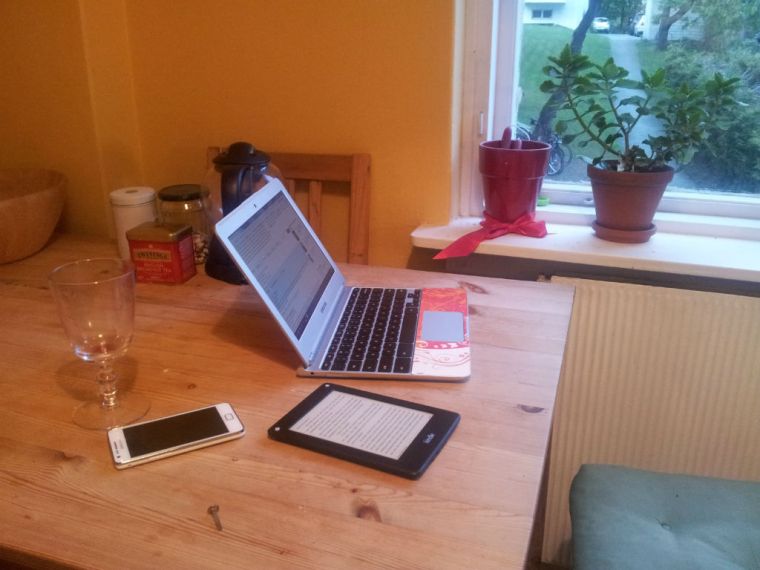Last time I invited Kim Linwood over to talk about the spanking success of Rebel, her debut stepbrother romance (no blood-related MCs, big HEA) and her method, I ended up publishing one of the most read and widely shared posts on this blog (here is the interview if you missed it). Her second outing with Bossy in the same sub-genre was equally successful, proving that she’s here to stay. I’m super excited to have Kim back to give us the lowdown on how she repeated her feat of producing a book that topped Kindle categories and shot up the Kindle bestseller list.
Welcome back, Kim! Are you ready for another third degree? Your success is too good not to be shared. Let’s start with your writing process. Bossy was published four months after Rebel but still, having read both books, I felt you have grown as an author. What are the writing areas that you worked on more this time around?
Thank you! I feel like Bossy is a better book, but it’s really difficult to evaluate when you’re so close to the source. By the time you’ve read over the book for the millionth time, you’re convinced it’s terrible, completely unfunny and hopelessly unromantic.
This time I tried to work on character depth and story depth, without losing the humor and plain fun that I try to inject into my stories. Declan and Claire’s relationship builds more naturally in Bossy, I think, and there’s a subplot narrative beyond just “I love/hate you” that helps drive the story and their relationship forwards. Obviously, the readers will determine whether I succeeded or not, but that was at least what I was going for. 🙂

You target a commercial, trendy romance niche: the stepbrother romance. Do you adjust your story to fit a specific mold? Do you follow a specific recipe or do you go by instinct?
This is a difficult question to answer. By writing to a niche, I suppose the answer is always going to be yes, since I keep the niche in mind while planning the book. On the other hand, it’s a type of book that I really enjoy writing, putting my personal touch to it. I think my books have a definite comedic aspect to them, and I try to make the characters bigger than life with a bunch of over the top antics, all while writing a solid romance with real emotions and a happy ending at the core of it. I think my style works pretty well for the stepbrother/bad boy tropes, so I guess the answer is yes and no. The niche guides my decisions when I plan the book, but they’re usually decisions I might’ve made anyway, so I’m not sure if those count as concessions or not.
You published Rebel in May with great results. What knowledge have you gained since in terms of marketing a book? What did you do differently this time?
To be honest, I’ll be following more or less the same plan. Rebel was #11 in the Amazon Kindle store at its best, and it’s impossible to not be very happy about that. Obviously, I was hoping for a repeat success, but while I was hopeful, it’d be crazy for me to expect it. It could be quite possible that Rebel was a fluke, or just happened to show up at the right place at the right time. It was my first novel, and with a sample size of one, it’s difficult to glean any meaningful data. So for now, I’ll keep going with what I know worked last time, and then in a month or two, I’ll look back at this launch and see if there’s anything I feel needs to change.

Do you see the stepbrother romance trend holding up? Is there another romance niche on the rise?
There are definitely fewer stepbrother novels hitting the top ranks these days, so the trend might be dying down, or there might just be a lull right now. That said, I still see authors doing well with them and I know there are more coming from authors I respect. I have a lot of fun with the trope, so I’ll probably keep at them while readers enjoy them. That said, bad boys and sassy heroines don’t really seem to go out of style, even if the specifics change. Whether they’re werewolves, bikers, stepbrothers, MMA fighters, or something else, I think they’ll be around in some form for a long time to come. Who knows, maybe I’ll even write a few with different tropes just to mix it up. 🙂
As for coming genres, I have hopes for science fiction romance. The new Star Wars movie comes out around Christmas, and authors like Ruby Lionsdrake and Mina Carter have had good luck with them. If they’re going to get to top 10 material, I don’t know, though. I think writing sci-fi would be a ton of fun, but contemporary romance does seem to be the vast majority of the bestsellers, but there was certainly periods for werewolves and vampires in the past, so maybe the fantastical will get another chance. There are many authors who are still doing really well in those categories.
I guess my answer is, I don’t know, but if it’s not stepbrothers, I think it’ll be difficult to go wrong with the bad boys in some format. 😉
I know you sent out over 300 ARCs which got you over 100 reviews on the first day of Bossy’s publication. With only one book out and a budding platform, how did you connect with such a large number of potential readers and got them to give up their email address?
Well, for Rebel, I sent out 113 ARCs, I think it was, so the first thing I did was to ask them to sign up if they wanted to do an ARC again. I do a new signup each time to keep the list fresh. I figure that’ll get rid of those who didn’t care for the previous book and probably aren’t a good match as an ARC reader anyway. Also, my mailing list had about 230 people on it at the time, so I offered all of them to sign up as ARC readers.
At the same time, I try to get to know other authors, especially ones who write in similar genres, and we’ll do newsletter exchanges, so several of my friends sent notes to their mailing lists asking for ARC signups. In addition, I used Facebook, but I do think the majority came from the newsletters and previous ARC reviewers.
Endorsement through newsletters. Awesome! I keep seeing indie authors adding a whole other book at the end of a new release (two even). You’ve also added Rebel in its entirety as a bonus novel in Bossy. Why an entire book when it’s already up on Amazon and not just the one chapter?
With the way Kindle Unlimited has changed to paying authors by the page, there’s really very little reason to not give the reader as much content as you can, with as low of a barrier as possible. If it’s as simple as flipping a page to start reading another of your books, the threshold is virtually zero, at least so long as the reader likes your writing to begin with. You still have to generate quality product, writing good stories well, or they’ll never get there. But so long as they do, it’s a win/win situation for author and reader.
That makes so much sense. So, readers, you see that writing well is just one of the talents a successful author possesses (although it’s the number one talent, and that will never change). But if sales matter to you, then you have to keep abreast of trends, pool resources with others, and keep those books coming out! (Maria, are you listening?)
Kim, thank you so much for allowing me to tap into your insights for the second time. Here’s to you coming over a third with another bestseller, equally jaw-dropping stats and more useful tips.
Thank you so much, and believe you me, I hope so too! 😉
Links used in this article:
Bossy: A Stepbrother Romance (with bonus novel Rebel): Amazon US– Amazon UK
Rebel: A Stepbrother Romance): Amazon US– Amazon UK
Kim’s first Q&A on MM Jaye writes
Connect with Kim Linwood
Site: http://kimlinwood.com
Twitter: https://twitter.com/kimlinwood
Facebook: http://facebook.com/kim.linwood











